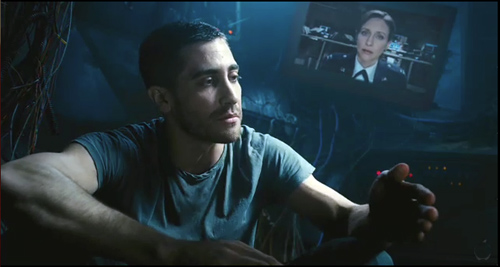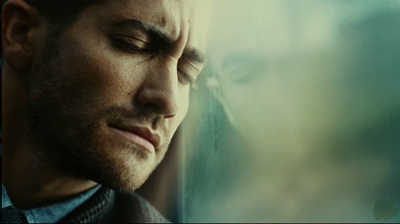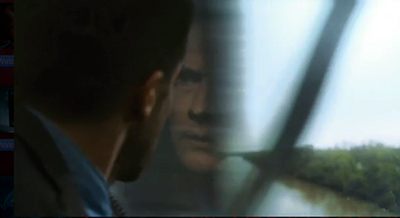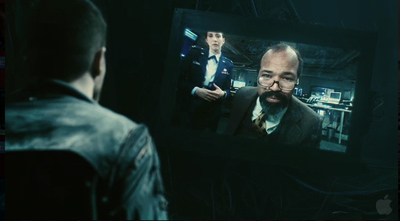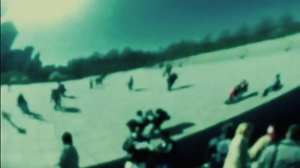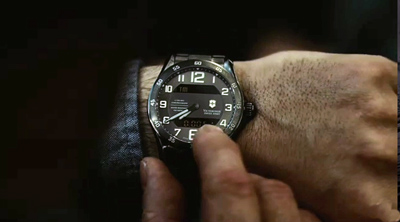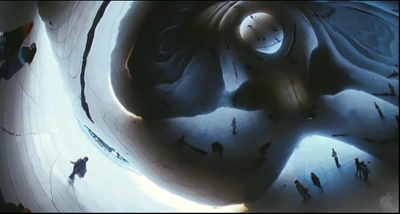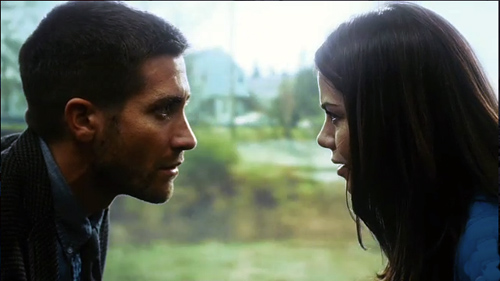Forking tracks: SOURCE CODE
Tuesday | May 3, 2011 open printable version
open printable version
Source Code.
DB here:
Who cares if the Source Code software is junk science? The muzzy premise forms the basis of an agreeable little thriller from the tail end of this year’s Dead Zone. Even if you don’t share my admiration for this movie, maybe I can persuade you that it points up an intriguing wrinkle in the recent history of American studio storytelling.
I surveyed this history in some books, but Source Code provides a nice occasion to update my argument. My main point remains: More than we often admit, today’s trends rely on yesterday’s traditions. Quite stable strategies of plotting, visual narration, and the like are still in play in our movies. When a movie does innovate in its storytelling, it needs to do so craftily. The more daring your narrative strategies, the more carefully, even redundantly, you need to map them out. The game demands clarity through varied repetition.
More generally, there’s a value in thinking of movies as combinations and transformations of inherited conventions. We’re used to considering conventions as matters of theme and genre, but I’m equally interested in conventions of technique and of narrative form. These are areas we’re still only starting to understand, although many entries on our site try to make progress in understanding changing norms of style and storytelling. (Check our Narrative Strategies category for further leads.)
If you haven’t seen Source Code, you shouldn’t read on. I reveal damn near everything.
He couldn’t come home
Colter Stevens awakes on a Chicago commuter train in the body of another man, Sean Ventress, who’s accompanying the attractive Christina Warren. Very soon the train explodes, and Colter reawakens in a pod in a military facility. He learns that after being shot down in Afghanistan he has been at the Nellis facility for two months, awaiting an experiment in “time realignment.”
Because a person’s brain activity does not cease immediately at death, memory modules can be accessed across an eight-minute period before full shutdown. Colter’s brain anatomy happens to be attuned to that of Ventress, so the experimenters can in effect insert his mind into Ventress’s body in the few minutes before the train explosion. The investigators know that the bomber is planning to set off a much bigger explosion in downtown Chicago, and Colter-as-Ventress could gather enough information to prevent it.
Under the tutelage of officer Goodwin and her superior, chief researcher Rutledge, Colter will be sent back in to the train, neurally speaking, to try to identify the bomber for them. He cannot prevent the train blowup, Rutledge insists. He can only hope to identify the bomber before the dirty bomb goes off downtown. But Colter can, in the shrinking time remaining, be sent back again and again, though it’s physically and emotionally punishing for him.
As a result, the film alternates between two zones of action. At the Nellis facility, time moves forward as Colter gradually comes to understand his circumstances and his mission. This action is under the pressure of a deadline: find the culprit before the dirty bomb is triggered. The other zone of action is the train, where the deadline is tighter (eight minutes before Ventress’s death) and the action is replayed as Colter tries different tactics to fulfill his charge.
Many incidents fill out this dynamic. In the pod, the early scenes are dominated by Colter’s efforts to understand the experiment he’s involved in and to grasp what has happened to him since his chopper crash. He is being kept alive artificially so that his brain activity can sync with Ventress’s. Eventually he breaks through Goodwin’s façade of coldness, converting her to sympathy for his plight. When she finally stares compassionately down at his broken body in its glowing casket, she resembles a mother or nurse looking down at a baby. On the train, the early scenes throw up some decoy suspects, most prominently an agitated man of vaguely Middle Eastern appearance. He is proven not to be the bomber, who’s eventually revealed as a dough-faced nerd. (Between the stereotyped Islamic terrorist and the stereotype domestic one, the plot opts for the latter.)
Colter not only blocks the Chicago bombing; with Goodwin’s help he is sent back one last time to stop the train bombing as well. In the course of that effort, he manages to reset the past, creating a parallel world in which the briefcase bomb never ignited and the bomber was captured before he left the train. Colter, dead at the Nellis facility, becomes Ventress wholly, able to spend a day with Christina and to send a text message to Goodwin promising that the Source Code has even bigger possibilities than Rutledge imagines. It can change the course of events. And she can reassure Colter’s original self, when he finally is sent on a mission: “Everything’s gonna be okay.”
It’s the new me
This plot is articulated in quite traditional ways. At less than 90 minutes, the film yields three large-scale parts or “acts.” The Setup introduces us to the premises, establishing the train bombing and the Nellis facility supervision; I’d argue that this ends at about 28 minutes. At this point Colter, has to rule out his chief suspect, the commuting businessman with motion sickness, when the train explosion takes place. The second stretch of the plot consists of more failed efforts, but culminates at about 56 minutes, when Colter correctly identifies the bomber, Derek Frost. Again, he can’t forestall the train bombing, but returning to his capsule he passes the key information to his masters, and they can arrest Derek before the dirty bomb hits Chicago. At this point his official mission is over. But the movie isn’t. Colter persuades Goodwin to let him go back one more time to stop the train bomb and save the passengers—effectively countermanding Rutledge’s injunction that the past can’t be altered. A three-minute epilogue starting around 82:00 wraps things up.
Filling out this structure is the characteristic double plot of classical Hollywood: heterosexual romance plus another, usually connected, line of action. The suspense plotline is organized as a series of goals, initially articulated by Goodwin. She tells Colter to find the bomb, which he does in the first replay. But as he can’t prevent the explosion, he needs to know more about who’s behind it. His next passes proceed in steps. He has to identify the guilty passenger; then he must try to steal the conductor’s pistol; then he searches for bomb-related paraphernalia.
About halfway through the film, however, Colter conceives purposes of his own. Inside the capsule, he probes Goodwin about what has happened to him. On the train, he starts to investigate the insignia of the agency controlling him, to trace his own fate in Afghanistan, to try to contact his father, and to phone the Nellis facility. He’ll eventually succeed in all these attempts, balancing the failures of the first chunk of the plot. Ultimately he’ll decide to try to save the train. Crucially, this last goal is formulated after he believes that having been more or less killed in Afghanistan, he is about to be terminated by the Source Code project. So he can now operate in a mode of pure self-sacrifice. As often happens in a classical film, a character finds the resources to throw off others’ demands and make decisions on his own.
In the romance plotline, by assuming the identity of Sean Fentress, Colter becomes attached to Christina. Now saving the train takes on a more personal weight; he will be saving her. The emotional dimension here is deepened by Colter’s backstory, his unresolved relation to his father. Eventually he is able to get closure by posing as Fentress and phoning tell the grieving old man that Colter indeed loved him. In screenwriters’ parlance, Colter is “exorcising his demons.”
Colter’s growing confidence in dealing with his past and the bomb threat changes his behavior toward Christina. No longer the skittish neurotic of his early incarnations, he becomes brisk and confident. Eventually he can relax, paying the standup comic across the aisle to entertain the other passengers. As often happens, character change is measured by a repetition. The first time Colter says, “It’s the new me,” he refers ironically to his discovery that he’s in another man’s body. But now, as the comic launches into his shtick, Christina points out that her companion has changed. He answers by saying, “It’s the new me,” which signals a deeper acceptance of his sacrificial role. He doesn’t expect to survive after he returns to the capsule, but he has saved the people on the train and he can for a moment celebrate a final moment of vitality.
This is not a simulation
These cascading goals and character arcs emerge gradually, thanks to cunning narration. At first we’re restricted largely to what Colter knows, but gradually our awareness widens. We come to learn about Goodwin’s role in the Source Code project and about Rutledge’s ruthless efforts to use Colter as a test case. By the climax, the film cuts freely between the two arenas, the train and the Nellis compound, creating classical suspense as Goodwin postpones erasing Colter’s memory while he races to prevent the train blowup. This is the Griffith heritage of the last-minute rescue.
For the viewer, the film starts with mystery—Colter is on the train and he doesn’t know who he is—and moves toward a mixture of curiosity about his past and suspense about how he will solve his problem. By the start of the climax, we have understood all the forces converging on Colter’s last mission, and sheer suspense takes over. There is, though, one final surprise, which seems to have worried other critics more than it does me. More on this shortly.
Even before the explicit widening of narrational knowledge, we’ve been given a dose of something enigmatic. The shifts from the train explosion to the Nellis pod are provided with whooshing transitions of blurred and fragmentary imagery that, as the film goes on, clarify a bit. At the film’s center, these images will be replaced by distorted flashbacks to his helicopter crash in Afghanistan, a passage that leads him to ask Goodwin: “Am I dead?”
One of the images glimpsed in the vortex montages is that of Anish Kapoor’s Cloud Gate sculpture, which Christina and Colter-as-Sean will visit in the epilogue.
Thematically, the image can be taken as an emblem of the lives Colter has saved, with a hazy overlay that reminds us of his floating consciousness for most of the movie. But the more basic question is about the status of these blurry visions. Are they Colter’s premonitions of a future to come? That assumption seems confirmed at the end when Colter, staring at the sculpture, asks Christina if she believes in Fate. At the same time, the images can be treated as coming from outside his ken, as if the film were providing teasing hints about how the action will resolve.
In these montages we see an interplay between destiny and chance common in Hollywood storytelling. (Christina answers Colter’s question by saying she’s “more of a dumb luck kind of girl.”) Very often, even if chance seems to govern the plot, a film’s overarching narration seems to “know” how things will turn out. Thus the film can have it both ways, acknowledging that life sometimes depends on chance but also recognizing that satisfying stories feel inevitable.
As usual, you will have eight minutes
Since the early 1990s, many films have resorted to what we might call“multiple-draft” plotting, the replaying of key scenes with important variations. Groundhog Day (1993) is our prototype, and it influenced Source Code screenwriter Ben Ripley. An earlier instance is the alternative futures revisited by Marty McFly in Back to the Future II (1989). Yet these films revived an older, although minor, trend going back quite far in Hollywood. The device was sometimes used to present alternative futures, as in The Love of Sunya (1927), but more commonly it presented different characters’ versions of what happened in the past. We find it in the courtroom drama Thru Different Eyes (1929), which dramatizes conflicting trial testimony, and in Crossfire (1947), which somewhat anticipates Rashomon‘s use of the strategy. Contradictory replays are used for more comic effect in The I Don’t Care Girl (1953) and Les Girls (1955).
What led to the resurgence of multiple-draft storytelling in our day? Partly, I think, the changing genre ecology of Hollywood. During the 1970s and 1980s, certain genres like the musical and the Western faded out, and horror and science-fiction/ technofantasy became more important. These genres, still going strong today, encourage playing around with subjective states (dreams, hallucinations), devising misleading narration, and creating branching and looping timelines (through time-travel, telepathy, multiverses, and the like). The filmic experiments probably owe something as well to the rise of popular writers in the vein of Stephen King and Michael Crichton, along with the revival of the work of Philip K. Dick.
Pop science also furnished new narrative possibilities. Researchers discovered the Butterfly Effect: change one little condition at the start of a process, and you get a different result. There was the Forking-Path, or Choose Your Own Adventure, option, whereby you can imagine taking a different path in your life. And there was the Multiple-Universe Hypothesis, whereby we can hop from one parallel world to another.
Even without the pseudoscientific justification, the reset-replay option showed up in films that were influenced by earlier storytelling. Film noir sometimes resorted to replaying scenes in ways that filled in information missing on the first pass (e.g., Mildred Pierce, 1945). Tarantino made no bones about being influenced by the overlapping flashbacks in The Killing (1955), themselves derived from Lionel White’s original novel Clean Break. So in the wake of Reservoir Dogs (1992) and Jackie Brown (1997), we got many thrillers and crime films that retold the same events from different characters’ viewpoints (Out of Sight, 1998), right up to an almost endless series of replays (Vantage Point, 2008).
All of these multiple-draft tactics made their way into global cinema too; Run Lola Run (1998) is a prominent example, but so too is the dazzling anime The Girl Who Leaped through Time (2006). In America, the market’s constant demand for something novel (but not too novel) pushed filmmakers toward all the variants we see in films as different as Thirteen Conversations about One Thing (2001) and Confidence (2003).
For mainstream filmmakers the key is redundancy. The reset-replay device has to be explained through dialogue, diagrams, intertitles, and sheer repetition so that we understand it going forward. (Contrast, say, Primer, which left most viewers behind.) Once we’ve grasped the similarities in the core situation, we can measure the differences in each iteration.
Source Code director Duncan Jones had already shown an interest in replays in Moon (2009), with its Möbius-band treatment of the crashed lunar vehicle, followed by Sam’s awakening in the infirmary. The mystery of the first encounter, in which Sam seems to find another version of himself in the vehicle, gets slowly cleared up through dialogue, the discovery of a secret repository, and not least important, a bandaged hand wound that allows us to keep the two Sams more or less distinct. Similarly, in Source Code, the returns to the train can be more elliptical as we master the situation: the introductory shots (duck pond, Colter waking up) can be skipped or compressed. Our training is guided by Colter’s, as he starts to predict the trivial incidents (coffee spill, cellphone call from Christina’s ex) and handle them matter-of-factly. These repetitions anchor us and allow us to register the different actions he undertakes in each module.
Those modules are ruled by another convention, what screenwriting manuals call the ticking clock. Usually reserved for the climax of films in all genres, even romantic comedies, the ticking clock plays a bigger role in Source Code. It governs both the macro-level (the deadline to stop the dirty bomb) and every return to the train. Strikingly, those replays are very strictly contained. Colter is assigned eight minutes for each mission, and by my count each of the developed train episodes before the climax consumes anywhere between four and eight minutes of screen duration, never more. His recurring deadline becomes a structural cell of the movie.
We have a chance to start over in the rubble
Déjà vu.
Multiple-draft storytelling promises to abandon the classic “linearity” of Hollywood storytelling, but the promise is largely a tease. The convention gestures toward unruly complication, but it tends to reinstall linearity, sorting everything out and making the final stretch of the film seem a logical consequence of what went before. Despite all the cycles and skip-backs of Groundhog Day, Phil changes incrementally into a kinder person and gets the woman he has come to deserve. In the money-drop sequence of Jackie Brown, the minute variations of point-of-view mesh into a single comprehensive account of how the scam went down. Part of the fascination of the technique for us may be similar to what a child feels after spinning around and stopping: the dizziness is fun, but so too is the bumpy readjustment to a stable world.
Source Code wants a happy ending. Does it prepare us sufficiently? We have the vortex transitions that look forward to the Cloud Gate epilogue, but are these enough? Don’t we need something at the level of plot action?
In his last visit to the train, Colter manages to disarm the briefcase bomb and capture Derek Frost. So now the train didn’t explode; the Nellis facility was never put on alert to forestall the dirty bomb; Rutledge and Goodwin never tried using Colter as their Source Code guinea pig. Rutledge earlier denied that this revision of the past would be possible, but the plot nonetheless moves us into a parallel world characteristic of forking-path plots like Run Lola Run and The Butterfly Effect (2004). And this reality has become sovereign, since Colter can now successfully send Goodwin a text message advising her about the unexpected success of the Source Code stratagem. This also means that as more or less a brain in a vat, the wounded Colter survives to serve in other missions.
Given the right sort of motivation, then, the forking-path option can be activated as a resolution device for multiple-draft plots. The film’s makers invoke a multiverse explanation explicitly in one piece of publicity for the film (trailer 2 here). More important, we’re prepared to accept such a switch on pretty slender evidence. Counterfactual thinking in terms of forking paths is a part of our folk psychology. If only we’d left the parking lot ten minutes earlier, we wouldn’t have hit this traffic. If I hadn’t taken this job, I wouldn’t have met my husband….and so on. Despite what experts like Rutledge say, when we see Colter disarm the lethal briefcase, we’re prepared to buy the possibility that everything afterward has changed.
Still, we need some elements in the movie itself to justify the jump. During his final questioning of Goodwin, Colter asks if she could imagine a world in which she didn’t get divorced, being “a woman who took a different fork in the road.” Colter insists that the course of events is changeable: Christina “doesn’t have to be dead.” At various points he says he thinks he can save the train, but like Rutledge, Goodwin reasserts that there’s only one reality, and its events have already happened.
Interestingly, the debate itself might be a minor convention of the multiple-draft plot. In Tony Scott’s Déjà vu, (2006) a close analogue to Source Code, two scientists disagree about whether the past is malleable. Professor Denny says that you cannot change what’s already happened. “God’s mind is made up about this.” But his colleague Shanti adheres to the “branching universe theory,” which she helpfully draws on paper for our benefit (echoing Doc’s famous diagram in Back to the Future II). A significant event, Shanti maintains, can shift the course of events and create a new path. It can even, she claims, wipe out the branch that was initially taken as baseline reality.
Images of linearity deflected, of hiccups and branches off a main line, show up in Source Code too. The train bomb is fired off just as another train passes on a parallel track. But in the final replay, after Colter has set things right and paid the comedian to do his turn, we see “all this life”—the passengers frozen in amusement. The shot is a kind of marker that, as Shanti puts it, something big has changed. Abruptly we get a shot we haven’t seen before: a high angle of our train switching to another track. Then we cut back to Colter and Christina about to kiss, as the rival train passes safely. Our train’s new trajectory confirms that an alternate reality has been put in place. It also echoes an earlier line, when Christina, talking about her plans for the future, asks Colter: “Am I on the right track?”
This will end
Source Code appropriates the forking-path option in order to arrive at a final draft of Colter’s fate. This stratagem reflects a common tendency in the history of narrative forms. Over the years, as readers become more skilled in picking up conventions, authors can be more elliptical and oblique. Descriptions can be more bare-bones, and authorial commentary can be given in a phrase rather than a paragraph. (Elmore Leonard: “I leave out the parts that readers skip.”) Films that once needed to motivate alternative futures through dreams or fortune-telling now do so through scientific gadgetry, or just by referencing similar movies.
We surely lose something in a trend toward such laconic storytelling, but there are gains in speed and impact. What Déjà vu debates for minutes can be abbreviated in Source Code because audiences have caught on: a few cues suffice to let us figure out how this sort of story goes. For me, the very premise of the replay device, plus Colter’s raising the issue of forking paths with Goodwin, plus our commonsense psychology, plus the swooshes, plus the convention of the happy wrapup, not to mention the overall urge to reward our our hero for all his sacrifice—all this is enough to push the ending over the finish line.
More generally, you can invoke Steven Johnson’s argument that we’re getting smarter about picking up quickly-emerging conventions. Popular culture, he claims, is more intellectually demanding than it used to be; examples would be The Wire and Lost. I’m not wholly convinced, since Our Mutual Friend and other items consumed by generations past can be pretty complex, and twentieth-century middlebrow artists like Thornton Wilder, J. B. Priestley, and Alan Ayckbourn have flirted with formal experiment. I’d relate the intricacy of some popular narratives partly to the proliferation of more niche genres and specialized publics, along with the growth of pop connoisseurship. Aging hipsters and cool college-educated youngsters, fortified with high disposable incomes, now flaunt a nerdy side and enjoy avant-gardish innovations.
For whatever reasons, in a lot of mass storytelling, form is the new content. But that newness depends considerably on recasting long-standing traditions. Nothing comes from nothing. And it can be fun to trace the fluctuating dynamic of novelty and familiarity as it emerges in the movies that we see right now.
At Electric Sheep Duncan Jones elaborates on the forking-path dimension of his film.
This entry builds on work I’ve done elsewhere. For more on classical conventions of plotting and narration, see The Classical Hollywood Cinema: Film Style and Mode of Production to 1960, part one, and Narration in the Fiction Film, Chapter 9. On recent narrative innovations and their relation to classical premises, see The Way Hollywood Tells It: Story and Style in Modern Movies, 51-103. On forking-path plots and their relation to folk psychology, see the essay “Film Futures” in Poetics of Cinema. One essay in that volume discusses Mildred Pierce‘s tricky replay of the opening murder, while another surveys another contemporary trend, the network narrative.
On dividing a film’s plot into parts, see Kristin’s earlier entry and my essay on Mission: Impossible III. Go here to see what happens when Archie Andrews takes a forking path.
Yes, there’s something similar to be done with The Adjustment Bureau. But I leave that to others.
Source Code.












